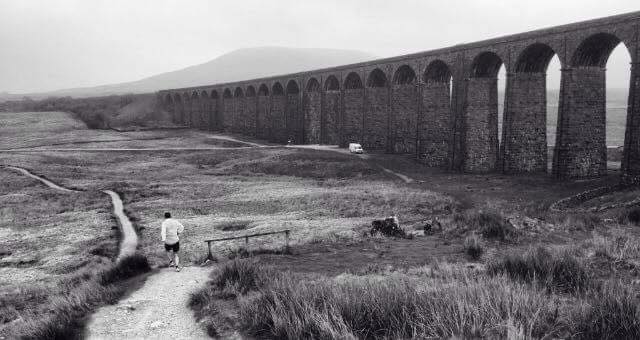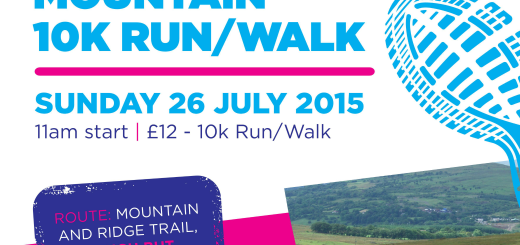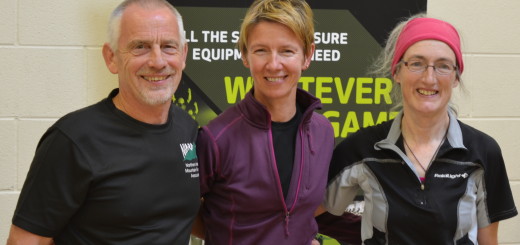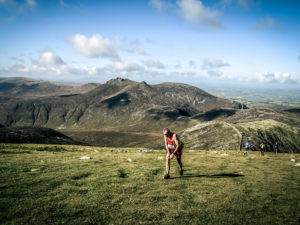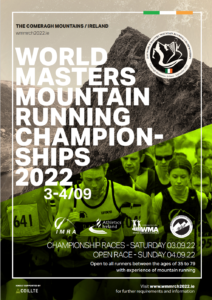Yorkshire ‘Three Peaks’ Fell Race
By Justin Maxwell
With the Ultra Trail World Championships (at the end of May) in mind I reluctantly decided to withdraw from the 53 mile HOKA Highland Fling, opting to take on a similarly challenging event but covering less miles. The well-known Three Peaks Fell Race was taking place the same weekend, with in excess of 23 miles and 1600 metres of Ascent/Descent I figured this would be a perfect alternative and a good start to a tough training weekend.
I’ve decided to add my thoughts on the Three Peaks event, the route and how the race panned out, as a way of promoting it to NIMRA members, most of whom will have heard of the race. I know other races such as Carneathy and Ben Nevis do attract a good Northern Ireland crowd and I feel the Three Peaks race could have the same draw in years to come.
I only booked the trip about three weeks ago. The Easyjet flights from Belfast International to Manchester worked out around £40 per person (with hand luggage only). We flew out early on Friday morning and returned on the last flight back on Saturday night. I hired a car from Manchester Airport, it also cost around £40. £40 seems to be the going rate, as our B&B accommodation at Dalesbridge House was the same. Dalesbridge House is approximately 4-5 miles from Horton-in-Ribblehead (Race Start/Finish) and Settle (the nearest shops/village). From the airport, it took us around 1 hour 45 minutes to get there. The accommodation offers en-suite rooms and bunk house options, the £40 we paid (each) was for a twin room with en-suite. The staff were nice and were very accommodating.
The race itself started at 10.30am on the Saturday. I wanted to be at registration for 8.30ish. When 1000 runners and spectators arrive in a small hamlet like Horton, I envisaged chaos, but the organisation was quite slick. The registration was equally as smooth and there was plenty of room to hang about and chat to other runners and check out retailers such as Pete Bland. Registration was £35 and this year, to my knowledge, the event hadn’t sold out. This may or may not have been due to the fact that The Fellsman and the HOKA Highland Fling fell on the same date. That’s not to mention the 26.2 mile road race taking place in London the next day!
At 10.30am exactly, the shot guns were fired and we set off. Salomon’s ultra and fell running specialist Ricky Lightfoot lead the runners out of the main field onto the road, closely followed by former British Fell running Champion Joe Symonds, Welsh Commonwealth games Marathoner Andrew Davies and winner of the inaugural Mourne Skyline MTR Kim Collison. Regular visitor to Northern Ireland, Rob Jebb and the ever improving Andrew Fallas also made sure that they weren’t being left behind. After less than a mile of road, we turned left onto a track leading to the first summit Pen Y Ghent. The track was rocky and the gradient increased gradually, with a few flatter sections thrown in, to help recovery! Once the track met the Pennine Way, it was mainly gravel to the summit (similar to Castlewellan’s climbs). This uphill is runnable and although this was the biggest climb on the Three Peaks course it was the easiest (for me) to ascend. Ricky Lightfoot reached the top in 28 minutes 11 seconds, it took me 33.32. Once we dibbed in at the top, there was a short grassy downhill (with a small rocky section), before we again met the Pennine Way and descended the trail that we had come up. This downhill was very fast and apart from one or two small bumps, there was a lot of good running on trail and short smooth grass until we reached the 1 mile road section before the Ribblehead Aid Station at about 10 miles.
From Ribblehead, the route covers approximately 1 mile of undulating gravel trail, before turning left onto the second ascent – to the summit of Whernside. This was my least favourite climb, it had everything I don’t like! Whernside started with a river crossing and then a long gradual slog over wet, rough ground. I would compare this part of the course to last year’s British Championship climb from the quarry to Donard. On Saturday, the last section of the ascent was very very steep, steeper than the final stages of the ‘Lurig’ climb and for a good bit longer, for those familiar with it. I lost a lot of places on this section. The descent off Whernside wasn’t bad, I would compare it to the Glen River path descent, on a wet day. In the latter stages of this section, there is about 1 mile of tarmac before the ‘Hill Inn’ Aid Station.
Ingleborough is the final summit on the route. From the Checkpoint at the Hill Inn, the climb is gradual and on grass for about one mile. After a mile the grass changes to wooden boards. In a few places the boards have steps, but definitely manageable if your intention is to run them. Closer to the summit, I felt I was faced with a wall. The wall was the final ascent to the peak and comprised of very steep rocky steps, at times I was using my hands to help climb. It took me around 6-8 minutes to cover this short section. Once this part was over, it was again a steady run to the top, on good track. From the misty and sleety mountain top, I encountered the roughest descent of the Three Peaks race, a very rocky, but short scramble through big and spikey rocks. These were kind of like a shorter version of the descent from Meelmore towards Bearnagh, but the rocks were a tad more dangerous (in my opinion). Once this section was out of the way, there was more good flat or slightly downhill running for 1.5 or 2 miles, before I reached the ‘limestone’ field. On Saturday the limestone was wet and muddy, it made running quite slow, but with a bit of concentration and patience it was soon over and again the running was good between here and the finish back in Horton. I finished in 3 hours 33 minutes, in 60th place. Before the race, I figured 3.30 was a respectable time, based on the 2014 results and the competitors I knew from them.
Ricky Lightfoot won the 2015 race in 2.51:42, Andrew Davies was 2nd in 2.53:53 and Andrew Fallas completed the podium in 2.57:51.
A strong Helen Bonsor (Carnethy HRC) won the female race, finishing in 3.27:44, Inov8’s Anna Lupton was 2nd in 2.34:46, with accomplished fell runner Caitlin Rice taking 3rd in 3.39:03.
In summary, I feel that the race is achievable to a big percentage of NIMRA members and friends. Although 23 miles long, there is a lot of good running throughout the course and the ascent/descents are (dare I say it) more manageable than what we are faced with on a weekly basis. Like most races I run nowadays, I’m comparing our home-grown talent to other competitors in the field and the challenge of the course. Aside for masses, I feel that our top runners would get on very well here, as would anyone who focussed on the challenge. For those not so fussed on navigation, I did not need to get a map out at any point. With some pre-event research, so many runners around and the ‘controversial’ areas flagged, you’d do well to get lost.
This race is usually planned for the end of April and a good achievable target once we get Christmas out of the way. I’ll definitely consider this event for 2016 and I would encourage others to do the same. If any person requires any further information, please feel free to get in touch.
Thanks to Ricky Cowan for the advice on the route, Ryan for the encouragement and assistance on the course and various NIMRA members and friends for their messages of encouragement.

